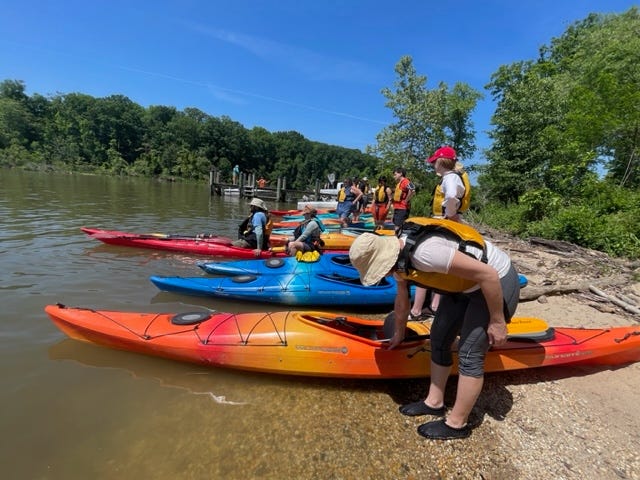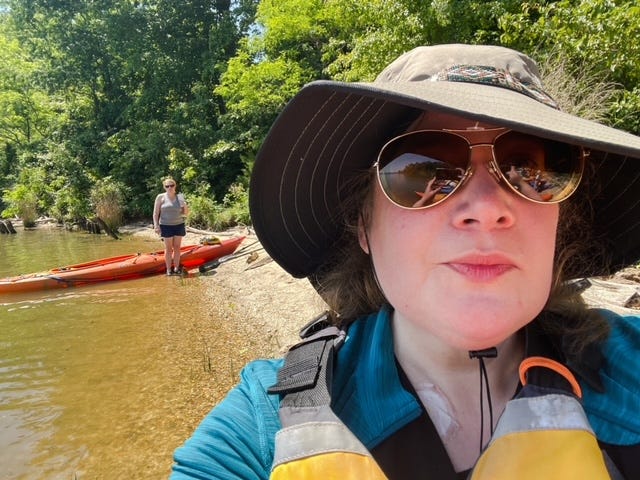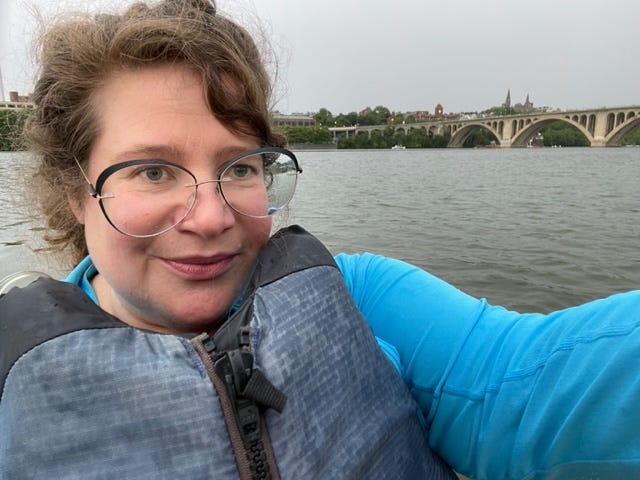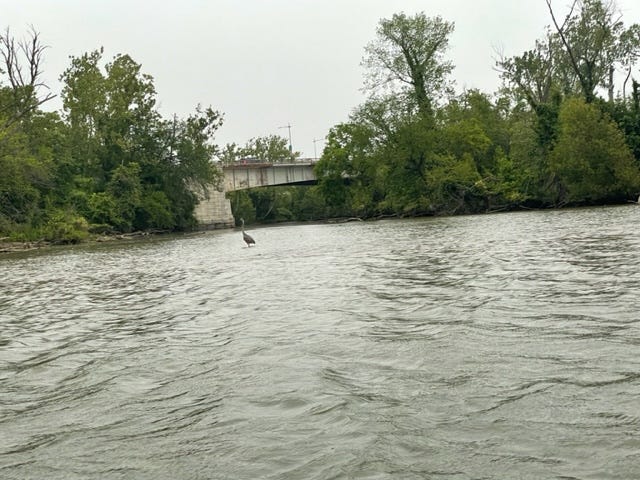Hi fellow wanderers,
Do you know someone who might enjoy wandering with us? Please feel free to forward this newsletter to them.
Or if you’ve read this newsletter before but aren’t a subscriber — why not subscribe? :)
Enjoy!
I’ve been thinking a lot about Nobody’s Fool lately, the Richard Russo novel and, as it turns out, movie from the mid-nineties starring Paul Newman, Jessica Tandy, and Bruce Willis. (I haven’t seen the movie but plan on watching it soon.)
Though I just found out about the movie, the book was one of those obsession books for me about a decade ago. I’d get to the end of it and immediately start again, like I was thumbing through one of those cartoon flip books that you can run backwards and forwards.
I couldn’t get over the two main characters, a lovable ner-do-well and a retired high school English teacher, an odd couple living together in a house with a tree that’s dying in the front yard. All the trees are dying in all the town’s front yards — they were planted at the same time, an alleyway of foliage during the town’s heyday and now that the town’s down on its luck, the trees are dying at the same time too.
It’s that kind of book. Everything’s tight. There’s a gun, and you can be sure someone’s shooting it by the third act.
Mrs. Beryl, the former English teacher, notices everything. In the opening scene, she notices the dying trees, wonders when a branch will fall and where. (A branch does fall, later in the book.) She notices how her friend drives (too slowly) …. and she notices a lot about Sully that she overlooks. He smokes in the house, for one thing, which she wishes he wouldn’t do. He smokes and forgets to put out his cigarette, goes to sleep with it half-smoked. He could burn the house down (but she doesn’t think he will).
Sully doesn’t notice a thing except what’s right in front of him. If it’s work, he does it. If it’s cash, he spends it. If it’s a woman — well, he has some standards but he knows what to do with a woman.
This irritates the bejesus out of almost everyone in his life but I gotta say — I think I have at least a little bit of Sully in me, as well as a lot of Mrs. Beryl. I think everyone probably does, at least to some extent, these two odd characters living in a crumbling house in a dying town, noticing everything and not noticing a thing, making plans and also just doing what’s right in front of you, playing them as they lay.
I don’t think it’s possible to kayak without a jigger of Sully for courage, burning in your gut — that’s how I feel anyway, the few times I’ve gotten in a kayak. That moment of terror, when you’re in a hole in the water, floating, somehow, at the water’s edge.
I’ve taken a few kayak trips recently: one with friend and collaborator Thomas Pluck and now twice with friend & friend of the newsletter Diana.
Tom and I shared the moment of terror together — it was his first time kayaking, it was my first time in years — but Diana didn’t know about the moment of terror, that moment when you first get in the boat, and there you are, all on your own, pretty much eye level with a vast expanse of water.
I thought everyone knew about the moment of terror.
As it turned out, Diana grew up spending summers at a family cabin by a lake. She was always in and out of boats, constantly swimming and splashing about. Even falling in wasn’t a big deal — she did it all the time, when she was learning. Maybe she had the terror so long ago in childhood she can’t remember it now. Maybe she never had the terror at all.
“So, what’s the terror?” she asked.
I don’t think it’s exactly the fear of landing in the drink, though that’s part of it, for me. Capsizing, though, seems like a logical fear. The terror is something else.
It’s the water itself, the brownness of it, its expanse, the little laps at the boat like kitten tongues, rougher than they mean to be. How low I am, the utterly changed perspective. I’m a bird, cormorant with its neck outstretched but I’m at the mercy, I’m out of my element.
That’s not what I tell Diana. I can’t remember what I tell her, something about falling, capsizing probably. “It lasts five, ten minutes,” I say. It lasts longer.
Into the terror, you paddle.
That’s what happened with the first kayak trip, the one with Tom. It was a trip with REI, we had trainers. As Tom put it
“The instructors, who both looked like they camped in every season and could start a fire with a granola bar wrapper and clump of wet chai leaves, told us that only people playing with their phones capsized.”
(I played with my phone. Or at any rate I took pictures with my phone. Did I mention I have a little bit of Sully in me?)
The overly-healthy instructors taught us how to hold the paddle, how not to tip the kayak and then we were off. And despite the terror, there we were, in the open, one stroke after another. I tried kayaking around the group, I realized I couldn’t steer worth a damn. I was eye level to an egret.
We were kayaking around sunken skips, a story which should have been interesting but, oddly, wasn’t for long stretches. The Mallows Bay-Potomac River National Marine Sanctuary was the first National Marine sanctuary in 19 years. The ships themselves were somewhat shoddily built in a race to keep supplies moving at the end of World War I; when the war was won, the race was lost in that the government had spent millions on ships that they then couldn’t unload.
What followed was the kind of bureaucratic storyline that might entertain a true DC die-hard but no one else, all about DOD acquisitions. The gist was that, despite trying to sell these ships — and even succeeding on one occasion — the ships never stayed bought.
Finally the depression hit, people realized there was a bit of metal on the ships, and a something of an industry sprung up as men poured onto the now-rotting ship hulls to strip what they could.
They weren’t the only ones stripping. Where there were desperate men, there were equally desperate women, and where there were both, there was plenty of moonshine.
At one point, the almost-sunken-ship-stripping-industry and all of its hangers-on was the biggest business in Maryland, until a great fire came (possibly by accident, possibly not) and burned the whole thing, every ship, deep into the bay. It was said you could hear the shrieks of the rats for miles.
And that’s how things stood for a long, long time. Long enough that the fish realized that the leftover ship skeletons made a pretty good reef of sorts — a barrier from strong waves and predators.
Long enough for the predators like osprey to nest there and try to hunt the fish anyway.
Long enough that, when people came back around again to take a look at the place, they realized that inadvertently, what was left was a pretty amazing environmental preservation area. Elsewhere, erosion was destroying the bay; here, the ghosts of the old ships had taken root like trees and had saved the soil, the plants, and the animals.
Maybe after watching the world’s chillest osprey, I should have felt less terror when going out with Diana a few weeks later.
But probably, I should have felt more.
We knew it was going to rain. It started sprinkling just a few minutes after getting underway. “Do you want to turn around?” Diana asked me.
But the light rain actually felt good on my skin. And I was getting over the terror, and steering a bit better. “Let’s go around Roosevelt Island!” I said. (Where, incidentally, they have recently seen a bear. Teddy, is that you?)
We did, and saw several egrets and the Jefferson Memorial. It was raining steadily now, and we headed back.
And that was when the heavens opened. I still think we would have made it, despite the hail, but when we missed the 8 pm deadline, the very sweet college kid whose job it is to collect wayward kayakers came out on his speedboat and fished us out.
He went for Diana first and I thought she might tell him to get me instead — she knows what she’s doing, I don’t — but by that point, it wasn’t an option. “Get in,” he told her. Once we were both on and apologizing profusely he softened. “I never get to take out the speedboat,” he said, “it’s fine.”
As Diana put it, it was a very efficient adventure. Spending time with some egrets, seeing the monuments, kayaking through a storm, and getting rescued — all in a little over an hour. Plus, we totally would have made it back to the dock, given a little more time. :)
I’m planning on taking a canoeing and writing trip later this summer with Chris Latray as part of the FreeFlow Institute, so I’m trying to get out on the water more, get more used to boating, even if it’s not canoeing per se.
I’m trying to Mrs. Beryl it, plan for all the eventualities, and then here comes the storm, the terror, here comes Sully. I’m playing it like it lays, as best I can.
The government’s trash ships transforms into depression relief — no wait! — it’s transformed again, now it’s priceless ecosystem preservation.
I try to plan, but really I’m a Sully. Here’s the gun. How will it go off before the third act? I don’t know, I have to play it as it lays.
The trees are dying on my road but they’re dying slowly so far, leaf by leaf, branch by branch. Fingers crossed. Fingers crossed for us all.
Let me know if you have any adventures planned for your summer!
Also, I can’t help but share this:
On days when the Ichikawa City Zoo is closed, zookeepers let their alpacas roam the zoo. (They have fresh haircuts too!)













Thank you for all the kind words. It was a great trip, and thank you for suggesting it! I'll be buying a kayak this fall. And I need to read Nobody's Fool. I've only read Empire Falls by Russo, because my cousin Lou Taylor had a role in the miniseries. I liked it, but I know Fool Is his best book. There are 2 sequels now, have hot read them? I think you're right, that we should be both kinda of people... It's good to be observant but it can lead to a tightly knit life unless you have a little Sully in you. But you don't want to go fully that way. I think the Sullys of the world are more observant than we think, or self reflective, in the small hours they usually spend alone. But maybe I should read the book before pontificating.